
Sources of air pollution
Air pollution is a complex mix of particles and gases of both natural and human origins. It comes from many different sources.

Image: Sources of air pollution Defra: Air Pollution in the UK
In Bradford the main sources of air pollution are traffic, domestic combustion and industry.
Particulate matter (PM) and nitrogen dioxide (NO2) are both major components of urban air pollution and are the main pollutants measured in Bradford.
Nitrogen dioxide (NO2)
NO2 is a brown gas that is produced along with nitric oxide (NO) by combustion processes such as the burning of petrol or diesel in a combustion engine or the use of natural gas in a boiler. Together they are often referred to as oxides of nitrogen (NOx).
NO2 is a respiratory irritant that can cause inflammation of the airways leading to coughs, production of mucus and shortness of breath. Studies have shown that exposure to NO2 can result in reduced lung development, respiratory infections in early childhood and effects on lung function in adulthood.
The Bradford Clean Air Zone and Bradford’s Air Quality Management Areas were introduced because levels of NO2 in some parts of the city have previously been found to be too high.
Particulate Matter (PM)
PM is a term used to describe a complex mixture of solid and liquid particles of varying shape, size and composition. Some particles are emitted directly into the environment (primary PM); others are formed in the atmosphere through complex chemical reactions (secondary PM). The composition of PM varies greatly and depends on many factors, such as geographical location, emission sources and weather conditions.
The main outdoor sources of man-made particulate matter in Bradford are:
- combustion of fuels for heat and power (by vehicles, industry and domestic properties)
- physical processes such as tyre and brake wear, construction and quarrying, agricultural processes
- other activities such as bonfires and barbeques
Bonfires and wood burning stoves are significant sources of particle matter in some parts of Bradford.
Natural sources of particulate matter include wind-blown soil and dust, sea spray particles, and fires involving burning vegetation.